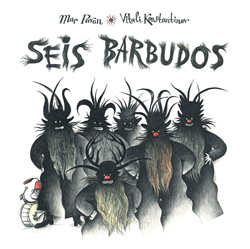< Back to posts
Vitali Konstantinov
Ukraine

Vitali Konstantinov was born in Ukraine and lives in Germany. After studying architecture, graphic arts, painting and art history, he became an illustrator, and has now illustrated books with publishers all over the world. Vitali was nominated for the German Children's Literature Award and The White Ravens Award.
In this post, Vitali shares some of his fantastic illustrations from ‘Seis Barbudos’ (Six Bearded Men), which was written by Mar Pavón and published in Spain by OQO Editora. Vitali talks about the challenge of illustrating Mar's text, which is very open to interpretation.
Vitali: The text for ‘Seis Barbudos’ is a little bit abstract and funny and has a strictly rhythmic structure - like a counting-out rhyme or like the famous song about the ten little... you know, indigenous guys, or ten brothers in the Yiddish tradition.
The author doesn't define exactly who the protagonists are. We only read about other people's reaction when they meet the Barbudos; they are irritated, shocked, suspicious, and nobody expects anything good from them at all. But all the Barbudos want to do is buy some bread, chorizo, fairy tale books and various other things. So I saw this as a story about tolerance and intolerance, and about prejudices.
I live as an immigrant in Germany – I'm not blonde and I have a full beard – so I know very well what it means to be a stranger... especially a bearded stranger! Furthermore, men with long beards are usually representative of some marginal groups in society: religious fundamentalists (Islamic, Jewish, Orthodox Christians, etc), bikers, yogis, hippies, artists, hobos, etc. Even the word ‘hobo’ in Italian is ‘barbone’ – from ‘barba’, which means ‘beard’.
The first challenge for me was how I should represent these bearded characters in the illustrations. I didn't want any religious allusions in there. It's a funny children's book after all!
Eventially, I found the solution...
Throughout the book, I illustrated the Barbudos as mysterious, unidentifiable, ominous silhouettes. But of course, I know who they are!
All the mysterious preparations the Barbudos are doing in the book are for the birthday party of a poor boy – this is the surprise happy ending in the text. But to add another narrative layer with the illustrations, on the final page I surprise the reader (hopefully) by revealing the true identity of the Barbudos. I won't reveal the funny joke here; the book is available!
The second challenge was drawing the imaginary vehicles. Each Barbudo goes away (don't worry, they're not killed off!) in a strange vehicle. The author invented crazy names for the vehicles, so I had to learn the spanish wordplay and then design a ‘petal-wheel’, ‘monkey-bus’ and more. For me, this book is a good example of the relationship between words and pictures – between ‘show’ and ‘don't show’ – ‘tell’ and ‘don't tell’.
With my books, there's a flowing transition from sketching to final artwork. I don't really like to keep my sketches and normally I just cast them away; if you're going to a restaurant for dinner, it's best you don't see their kitchen, right? However, for this post I found some scribbles (although I hesitated in showing them!). Here's my first storyboard and a composition idea for one of the spreads, as well as my first attempt at the characters using a different technique (coloured ink).
What about the technique I used for the final illustrations? It's the most simple technique in the world: pencil and crayon drawings on paper. Okay, I used a very good handmade French paper and the best German fixative!
Illustrations © Vitali Konstantinov. Post edited by dPICTUS.
Seis Barbudos / Six Bearded Men
Mar Pavón & Vitali Konstantinov
OQO Editora, Spain, 2012
Six bearded men walk into a bakery. The baker falls to the floor, shocked. The customers are terrified. These bearded men are surely up to no good!
This story cleverly shows you how misleading appearances can be, as the striking illustrations evolve from being dark and foreboding to colourful and friendly.
It's not always wise to trust your first impressions.











